It is important when getting interested and excited about new things to look at its lineage. Something I often did in my series of articles over the years in Flush Magazine
So with the current rush of Virtual Reality gaming and experiences and the slew of new kit we have some very interesting near off the shelf kit such as this.
*warning it contains violence (see where I am on that here)
However, back in the 90’s we had VR kit like Virtuality (they must be kicking themselves for be too early for the masses. Though thats a curse us early adopters and evangelists have to live with 🙂
The headsets were quite heavy and the container you stood or sat in was not a treadmill but part of the sensing rig.
The graphics may look old fashioned and clunky but they were good experiences. When I was at poly/uni in Leicester getting ready to do a year out this was the company I wanted to go and work for if I had a chance too. They sent to me IBM instead. Though as you can see from the Virtuality company details they had very close ties with IBM. So it was close 🙂 It i also funny how things work out.
Still, it is very cool having all these headset sat around me and some that just work on my portable communication device too 🙂
Over 15 years experience in Virtual Worlds, 30+ in tech – What now?
A few days ago I realised it has been over 9 years since I first publicly blogged about how important I thought the principles of the metaverse and virtual worlds were going to be for both social and business uses. This post, pictured below for completeness was a tipping point for some radical changes in many of our lives as part of Eightbar.
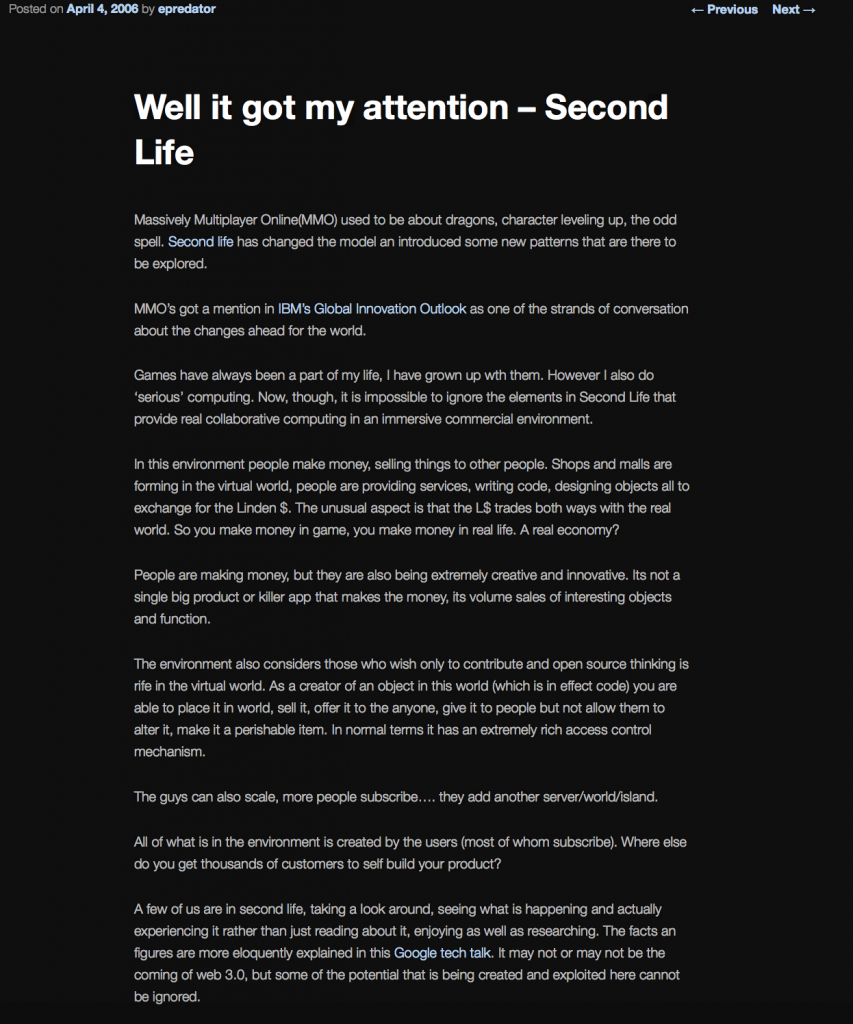
I had been working to that sort of point of understanding though since some very early work with virtual environments and how people get to interact with one another in them around 1999/2000 with SmartVR trying to keep the social bond in our internal web and multi media design group together when we were cast asunder to different locations by business pressures (or bad decisions who knows!). I knew we had to have a sense of one another existence aside from text in emails and instant messages. So we tried to build a merged version of both offices as if they were in one place. The aim to then instrument those with presence and the ability to walk over to someone’s desk and talk. Mirror world, blended reality and even internet of things, Yes I know, a bit before its time! Cue music, “Story of my life” by 1D 🙂
We definitely had a technology and expectation bubble later 2006-2009. However, that, as with all emerging technology is all part of the evolution. The garnet curve et al. What surprises me the most still is that people think when a bubble like that bursts that its all over. That somehow everything that was learned in that time was pointless. “Are virtual worlds still a thing?” etc. I feel for the even earlier pioneers like Bruce Damer, who patiently put up with our ramblings as we all rushed to discover and feel for ourselves those things he already knew.
Increasingly I am talking to new startup ands seeing new activity in the virtual space. The same use cases, the same sparks of creativity that we had in the previous wave(s), the same infectious passion to do something interesting and worthwhile. Sometimes this is somehow differentiated from the last wave of virtual worlds under the heading of virtual reality. The current wave is focussed on the devices, the removal of keyboard and of a fixed screen. The Oculus Rift, HoloLens etc. However, thats a layer of new things to learn and experience on what we have already been through. After all its a virtual world you end up looking at or blending with in a VR headset!
I spend so much time looking forward and extrapolating concepts and ideas it is now very scary to look back and consider the experience I have gathered. The war stories and success stories, the concepts and ideas that I have tried. The emotional impact of virtual worlds. The evolution of the technology and of people’s expectation of that technology. The sheer number of people that have moved around in a 3d environment from an early age with things like Minecraft, who are now about to enter higher education and the workforce.
So I am left in a slightly bemused state as to what to do with this knowledge. With this all going so much more mainstream again I am no longer working in a niche. Do I ply my trade of independent consulting chipping away in odd places and helping and mentoring some of the new entrants in the market or do I try and find a bigger place to spread the word?
At the same time though, knowing lots of things makes you realise how much you don’t know. The imposter’s syndrome kicks in. Surely everyone must know all this stuff by now? It’s obvious and stands up to logical reasoning to try and connect with other people in as rich a way as possible. The network is there, the tech is there, the lineage is there. Though clearly not everyone gets it yet. I often wonder if the biggest naysayers I had to deal with on my journey so far have figured it out yet? It will probably turn out they will be getting rich quick right now whilst I sit and ponder such things.
On the other side of the virtual coin, I know from my martial arts that constant practice and investigation leads to a black belt. In the case of Choi Kwang Do that’s just over 3 years worth. So how many Dan worth of tech equivalent experience does that put me at. 25 years in the industry professionally but 30+ as techie.
I still want to do the right thing, to help others level themselves up. I don’t think I am craving fame and fortune but the ability to share and build is what drives me. If fame and fortune as a spokesperson, evangelist for some amazing idea or TV show reaches that end, then thats fine by me.
I am at a crossroads, my VR headset letting me look in all directions. I see half built roads in many directions. What now? A well funded company that I can help build a great road with, or forge off down one for the other paths seeing what happens on the way.
Of course that makes it seem like there is a clear choice on the plate. I suspect most of the the well funded companies and corporations don’t think they need any help, which is rather where I came in on this!
Needless to say I am always open to conversations, offers, partnerships, patronage, retainers and technology evangelist roles. There must be a slew of investors out there wondering what to put their money into, who need some sagely advice ;). Or that book… there is always that book… (600 images x 1000 words each 600,000 words just on these Second Life experiences. That’s just the ones with online. The offline ones double that!. Not to mention the other places, games, and self built experiences!
I took this photo in April 2006 as part of sharing of our journey

I have always liked a nice greenfield to start building on. Equally that did not build itself, it was a massive shared team experience. No one has all the answers. Some of us are good at helping people find them though.
Right! Can we get on with this now?
Silence isn’t golden – VOIP and Unity3d
Once again I am back on the trail of a good voice solution to use in Unity3d to use in multiple users situations. Having done a good few projects using a variety of solutions, mainly with an adjusted version of the now defunct Uspeak (as in removed from the assets store but replaced with Daiken Forge voice) combined with self hosted Photon server I think it must be time to find a more scalable solution. Very often the pressures of voice lead to a swamping of any server that is also dealing with position and data model synchronisation across the network. This clearly makes sense as there are only a few bytes of message for something moving a long distance, yet an audio stream is a constant collection of data flowing in and out of a server.
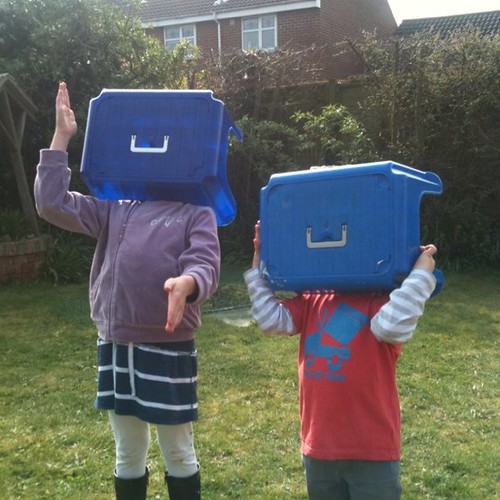
Whilst there is huge focus on VR for the eyes, being able to communicate needs more than one channel but voice is one of those.
A voice connection can be 100Kbps per person so without a different tuning or set of priorities the regular multiplayer data messages, even if they are reliable, will get lost on the noise of an open mic.
My projects up to now have ended up with a push to talk or even my scarily complicated dial, ring answer/engaged phone simulator in order to cut down on the amount of voice. Raising a hand to speak works in many formal situations but not in social collaboration.
So whilst we can squeeze voice packets onto the same socket server as the rest of the “stuff” it feels like it should be a separate service and thread.
Oddly there is not a solution just sitting there for Unity3d? It seems that many of the existing voice clients for games and related services just don’t play well in the Unity3d/c# environment.
Unfortunately this seems to be down to the generic nature of Unity3d (which is a major strength) compared with the specifics of PC architecture and also in how to deal with shared memory and pipes.
There are a lot of voice servers out there for games. Mumble/Murmur is a major one. it is open source and appears to bolt on top of many games even supporting a 3d positional audio.
Many games are of course closed code bases. So Mumble has to piggy back on top of the game or have a little bit of help form the game developers to drop some hooks in. The main problem seems to be the use of shared memory versus a more closed boundary of applications. Obviously a shared memory space to communicate can bring problems and hacks. Strangely it was shared memory and various uses of it that let us do the early client server work back in the 90’s scraping from a terminal screen to make a legacy CICs application work with a fancy GUI!. Initially I figured that there would be a c# client for mumble that any of us could drop into Unity3d and away we go. However there are a few unfinished or implementations being attempted. Connecting to mumble and dealing with text is fine but voice and the various implementations of encoding seems to be a sticking point. Mumble also has a web interface implemented through something called ICE which is another Remote Procedure Call set of interfaces. It seems to be again focussed on building with C++ or PHP. Whilst ICE for .Net exists it does not work on all platforms. I am still looking at this though as surely if a web interface works we can get it to work on Unity3d. Of course the open source world is wide and diverse so there is always a chance I am missing something?
If a Mumble, or similar client can exists in a Unity3d context then we have our solution. It is nice to have the entire interface you need inside Unity3d not side loaded or overlayed. However it may be that a solution is to have implement the web interfaces next door to a unity interface and use plugin to webpage communication as the control. This is fraught with errors, browsers, DOM’s, script fails etc. Just a nice drop in mumble client hooked u to the shiny new UI interfaces.
I looked at the others in the area, Teamspeak is one of the biggest but incurs licensing charges so is not very open source minded. Ventrillo and Vivox seem to have fallen away.
Then of course there are the actual phone voip packages and standards. Maybe they offer the answer. I used Freeswitch on Opensim to provide a voice channel. Maybe I need to look at those again.
Or another solution could be trying to persuade the socket server applications like Photon than they need to talk to more than one server. At the moment the assumption is one server connection (though the load balancing may occur further on the server itself). If the client knew to talk to a different configure machine and network that was happy to deal with the firehose of audio but the normal movements talked to the server configure to deal with normal movements then we might have a solution.
Either way, its not straight forward and hasn’t been totally solved yet, or if it has everyone is keep quiet (Yes thats ironic when talking about VOIP!)
Let me know if you do have some great opensource or open sourceable solution.
High Fidelity – A new metaverse – It’s here
A while back the original creator of Second Life (Philip Rosedale) announced a new ground up approach to shared virtual spaces taking in all the latest and greatest in tech. A few days ago I saw an email saying the alpha was live. The trouble was I thought it was an April fool joke. Not that I did;t believe it would come along but the timing was a bit odd.
However…. I registered (having been non the tell me more list since the beginning) downloaded the “interface” and voila….
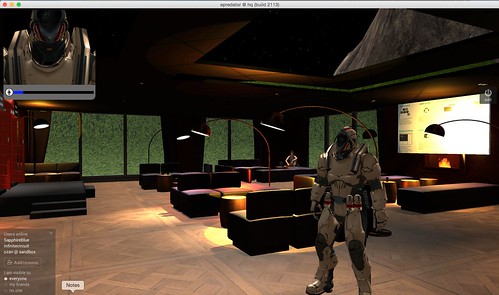
I did swap my mini robot avatar for a full mean machine one. Though there are a few more human and cartoon ones.
This is an alpha, it is not the final product things will improve but it feels very full on.
There are stacks of developer menu options and full support for all sorts of inputs, kinect etc, and outputs, Oculus Rift etc. There is a stack of documentation and youtube videos on how it works too. All to be expected but nice to see at at alpha stage.
I will of course look at building, scripting and hosting in due course. Javascript appears to be the script language of choice here, but that obviously depends on what library we get to talk to. There seems to be lots of terence to nice industry standard 3d models like FBX etc.
I jumped to another hosted area, the obligatory Sandbox and set my display name to epredator too of course 🙂 I might be new here, but I have been here before too 🙂
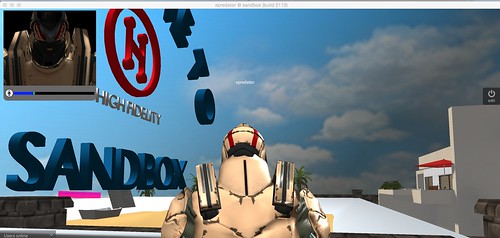
Lets see where this exciting development takes us.
Kids,video games, parents and ratings
There has been a lot of press and discussion about schools in the UK writing to parents to warn them about young children playing video games. Also indicating that allowing kids to play games rated 18 when they are underage is a sign of neglect and will lead to the parents being reported to police. The BBC covered it here
As a parent, as a school governor, an instructor and long term gamer it seems that this raises a few much more complex issues.
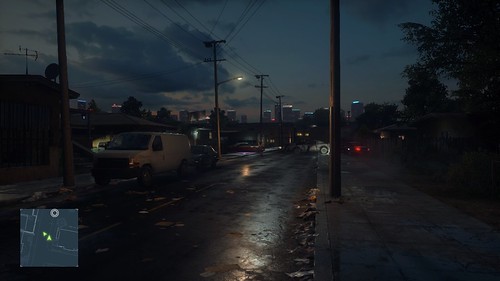
An 18 certificate on anything helps flag up content of a nature regarded as adult. However it does not indicate which of the adult themes it contains. You may notice on films on TV it will say its 18 but whether it contains violence, drug use, nudity, etc. That informs the viewer if they are sensitive or prefer not to watch such things to avoid it.
A parent should know what is in a product that they let their kids loose on. The 18 should be a big flag warning that there may be something in there that is not appropriate. However not all parts of all games are really 18 worthy. It is a marketing ploy to get more adult gamers to slip a few things in sometimes to warrant an 18. It also is down to individual parents bothering about how notice if their kids are affected or going to be affected by certain things.
Make no mistake though, there are some things in games that are really properly challenging and grown up experiences. Sometimes they can sneak up on you and often come as part of a wider narrative. As an example in Red Dead Redemption, an 18, the vast majority of the game is spent riding around the Wild West on a horse. Yes there are gun fights and shooting. However it is no more or less than watching a John Wayne movie.
“John Wayne – 1961” by 20th Century Fox – eBay. Licensed under Public Domain via Wikimedia Commons.
Cowboy movies sometimes have to deal with complex issues but they come in many flavours. There is always lots of shooting and death but it is the core and the intent of the film, either being light and comical or the more gritty true to life versions that form the spectrum. RDR seemed in the most part to be the former. I grew up watching westerns and we all had six shooters for toys.However about 2/3 through as the character arrives in Mexico a story telling cut scene featured graphic rape scene. Usually you get a sense and feel for the spirit of a game as you play it. You spot that it might be a cert 18 because of the “violence”, this though seemed a shift.
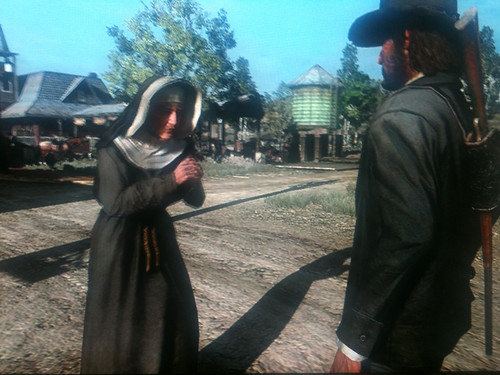
Now lets take Call of Duty (Bear in mind you can get Call of Duty Lego). The single player campaign game in all these games is a full on war film equivalent. However it is more Saving Private Ryan than Where Eagles Dare.
Both great films, but the former is realistic and disturbing, the latter is a playful romp. So single player you will experience some degree of story, probably torture, murder et al. Also some very strong language. It changes a great deal in multiplayer. Here teams of people online shoot at one another and work as teams to capture objectives. The violence is more Where Eagles Dare. It is frenetic and fast paced. The risk here comes from the other people, with headsets and voice turned on then all sorts of bullying and offensive language can take place, equally friendly banter and trash talk. Or, when done right excellent teamwork. The soundtrack itself features very little produced content. The narrative is what you make it.
In many ways the multiplayer COD is less worrying than what can happen on a Minecraft server. Minecraft as a game feature the ability for people to treat one another nicely or nastily. Whilst there is not usually voice you can spend ages building something for someone to come and mess it up accidentally or maliciously. It can also be a great place to learn online etiquette. Minecraft is not an 18. You kill things, but its regarded as cartoon and left alone. It has no story to warrant someone put in some nasty scenes to provide an emotion.
My point is that 18 is a flag, a warning sign. It takes a bit of effort to drill down if you are going to let kids experience the good parts of these.
I am happy for kids to shoot at one another in these games, it is just a twitch reaction game. I am not happy for them to play the single player experiences, those things crafted to shock and engage adults on adult themes. So I wonder if that makes me negligent? Being happy that kids can see some content that is put under an 18 certificate?
This of course is not what is going to happen. These warnings are to remind parents to be parents, to think about what they are doing, to help guide their kids.
Both the predlets are martial artists. They train in punching and kicking in ways that if used properly are very dangerous. They see punches and kicks all the time yet it is all done in a positive way, one that is not about the aggression of the will to dominate others. They are taught to not misuse what they learn in class. Does that mean that playing a fighting game with an rating over their age is not appropriate, often these at 16 like the UFC game or even WWE?
So all this comes down to context. To understanding when game does not mean light hearted play but intense narrative. It means understanding when competition is or isn’t healthy. It requires us as parents to understand a what is going on in these experiences and how we can find the appropriate path for our kids.
The age rating on these things is a relic of a past approach to media. It is very easy to classify 2 hours of celluloid, The 18 certificate is then a barrier to entry to a cinema when a person is selling a ticket, or even buying a DVD.
Games and their associated places are far more complex. They are playing fields where at different times with different groups very different things happen.
I am not totally sure how we can help all the parents out there. Many of course will just not bother to apply any thought at all and just let their kids on anything, on the basis it is easier.
A great week for science and tech, games, 3d printing and AR
There is always something going on in science and emerging technology. However some weeks just bring a bumper bundle of interesting things all at once. Here in the UK the biggest event had to been the near total eclipse of the Sun. We had some great coverage on the the TV with Stargazing live sending a plane up over the Faroe islands to capture the total eclipse. I was all armed and ready with a homemade pinhole camera.

This turned out great but unfortunately we were quite overcast here so it was of little use as a camera. I also spent the eclipse at Predlet 2.0 celebration assembly. They had the eclipse on the big screen for all the primary school kids to see. Whilst we had the lights off in the hall it did not get totally dark, but it did get a bit chilly. It was great that the school keyed into this major event that demonstrates the motion of the planets. So rather like the last one in 1999 I can certainly say I will remember where I was and what we were doing.(a conversation I had with @asanyfuleno on Twitter and Facebook)
This brings me on to our technological change and the trajectory we are on. In 1999 I was in IBM Hursley with my fellow Interactive Media Centre crew. A mix of designers, producers and techies and no suits. It was still the early days of the web and we were building all sorts of things for all sorts of clients. In particular during that eclipse it was some more work for Vauxhall cars. We downed tools briefly to look out across Hursley park to see the dusk settle in and flocks of birds head to roost thinking it was night.
It does not seem that long ago but… it is 16 years. When we were building those quite advanced websites Amazon was just starting, Flickr was 6 years away, Twitter about 7 years away, Facebook a mere 5 (but with a long lead time) and we were only on Grand Theft Auto II, still a top down pac man clone. We were connected to lots of our colleague son instant messaging but general communications were phone and SMS and of course email. So we were not tweeting and sharing pictures, or now as people do live feeds on Meerkat. Many people were not internet banking, trust in communications and computers was not high. We were pre dot.com boom/bust too. Not to mention no one really had much internet access out and about or at home. Certainly no wi-fi routers! We were all enthralled by the still excellent Matrix movie. The phone in that, the slide down communicator style Nokia being one of the iconic images of the decade.
NB. As I posted this I saw this wonderful lego remake of the lobby scene so just had to add it in this post 🙂
It was a wild time of innovation and one many of us remember fondly I think. People tended to leave us alone as we brought in money doing things no managers or career vultures knew to jump on. So that eclipse reminds me of a time I set on a path of trying to be in that zone all the time. I was back then getting my first samples from a company that made 3d printers as I was amazed at the principle, and I was pondering what we could do with designers that knew 3d and this emerging tech. We were also busy playing Quake and Unreal in shared virtual worlds across the LAN in our downtime so I was already forming my thoughts on our connection to one another through these environments. Having experiences that I still share today in a newer hi tech world where patterns are repeating themselves, but better and faster.
That leads me to another movie reference and in the spirit of staying in this zone. This footage of a new type of Terminator T-1000 style 3d manufacturing. 3D printers may not be mainstream as such but many more people get the concept of additive manufacture. Laying down layer after layer of material such as plastic. It is the same as we made coil clay pots out of snakes of rolled clay when we were at school. A newer form of 3D printing went a little viral on the inter webs this week from carbon3d.com. This exciting development pulls an object out of a resin. It is really the same layering principle but done in a much more sophisticated way. CLIP (Continuous Liquid Interface Production) balances exposing the resin to molecules to oxygen or to UV light. Oxygen keeps it as a liquid (hence left behind) and targeted UV light causes the resin to become solid, polymerization. Similar liquid based processes use lasers to fire into a resin. This one though slowly draws the object out of the resin. Giving it a slightly more ethereal or scifi look to it. It is also very quick in comparison to other methods. Whilst this video is going faster than actual speed it is still a matter of minutes rather than hours to create objects.
Another video doing the round that shows some interesting future developments is one from Google funded Magic Leap. This is a blended reality/augmented reality company. We already have Microsoft moving into the space with Hololens. Much of Magic Leap’s announcements have not been as clearly defined as one might hope. There is some magic coming and it is a leap. Microsoft of course had a great pre-release of Hololens, some impressive video but some equally impressive testimonials and articles from journalist and bloggers who got to experience the alpha kit. The video appeared to be a mock up but fairly believable.
Magic Leap were set to do a TED talk but apparently pulled out at the last minute and this video appeared instead.
It got a lot of people excited, which is the point, but it seems even more of a mock up video than any of the others. It is very ell done as the Lord of the Rings FX company Weta Workshop have a joint credit. The technology is clearly coming. I don’t think we are there yet in understanding and getting the sort of precise registration and overlays. We will, and one day it may look like this video. Of course it’s not just the tech but the design that has to keep up. If you are designing a game that has aliens coming out of the ceiling it will have a lot less impact if you try and play outside or in an atrium with a massive vaulted ceiling. The game has to understand not just where you are and what the physical space is like but how to use that space. Think about an blended reality board game, or an actual board game for that matter. The physical objects to play Risk, Monopoly etc require a large flat surface. Usually a table. You clear the table of obstructions and set up and play. Now a project board game could be done on any surface, Monopoly on the wall. It could even remove or project over things hung on the wall, obscure lights etc. It is relying on a degree of focus in one place. A fast moving shooting game where you walk around or look around will be reading the environment but the game design has to adjust what it throws at you to make it continue to make sense. We already have AR games looking for ghosts and creatures that just float around. They are interesting but not engaging enough. Full VR doesn’t have this problem as it replaces the entire world with a new view. Even in that there are lots of unanswered questions of design, how stories are told, cut scenes, attracting attention, user interfaces, reducing motion sickness etc. Blending with a physical world, where that world could be anywhere or anything is going to take a lot more early adopter suffering and a number of false starts and dead ends. It can of course combine with rapid 3d printing, creating new things in the real world that fit with the game or AR/BR experience. Yes thats more complexity, more things to try and figure out. It is why it is such a rich and vibrant subject.
Just bringing it back a little bit to another development this week. The latest in the Battlefield gaming franchise Battlefield Hardline went live. This, in case you don’t do games, is a 3d first person shooter. Previous games have been military, this one is cops and robbers in a modern Miami Vice tv style. One of the features of Battlefield is the massive online combat. It features large spaces and it makes you feel like a small spec in the map. Other shooters are more close in like Call of Duty. The large expanse means Battlefield can focus on things like vehicles. Flying helicopters and driving cars. Not just you though, you can be a pilot and deliver your colleagues to the drop zone whilst you gunner gives cover.
This new game has a great online multiplayer mode called hotwire that apps into vehicles really well. Usually game modes are capture the flag or holding a specify fixed point to win the game. In hotwire you grab a car/lorry etc and try and keep that safe. It means that you have to do some mad game driving weaving and dodging. It also means that you compatriots get to hand out of the windows of the car trying to shoot back at the bad guys. It is very funny and entertaining.
What also struck me was the 1 player game called “episodes”. This deliberately sticks with a TV cop show format as you play through the levels. After a level has finished the how you did page looks like Netflix with a next episode starts in 20 seconds down in the bottom right. If you quite a level before heading to the main menu it does a “next time in Battlefield Hardline” mini montage of the next episode. As the first cut scenes player I got a Miami Vice vibe which the main character then hit back by referencing it. It was great timing, and in joke, but one for us of a certain age where Miami Vice was the show to watch. Fantastic stuff.
I really like its style. It also has a logo builder on the website so in keeping with what I always do I built a version of the Feeding Edge logo in a Hardline style.
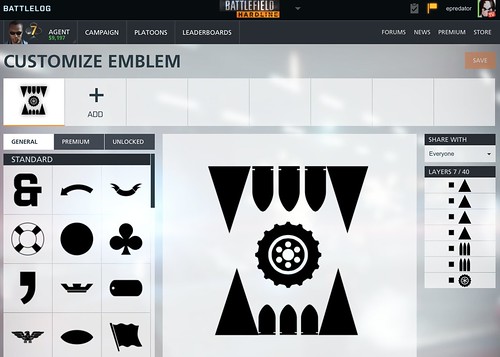
I may not be great at the game, as I bounce around looking for new experiences in games, but I do like a good bit of customisation to explore.
Unreal Engine – an evolution
As you may have noticed I am a big fan of Unity3d. It has been the main go to tool for much of my development work over the years. A while back I had started to look at Unreal Engine too. It would be remiss of me to say Unity is the way I have always done things so I will stick with that 😉 My initial look at Unreal Engine though left me a little cold. This was a few years ago when it started to become a little more available. As a programmer, and with a background in C++ I was more than happy to take on the engineering challenge. However it was almost too much being thrown at me in one go. There was a great deal of focus on the graphics side of things. It felt, at the time, more like a visual designers tool with code hidden away. This was different from Unity3d that seemed to cross that workflow boundary offering either simple code, complicated graphics, or vice versa.
The new version of Unreal Engine, now fully free unless you make a lot of money building something with it, in which case you pay seems a much more friendly beast now. It has clearly taken onboard the way Unity3d does things. That initial experience and the packaging of various types of complexity allowing you to unwrap and get down to the things you know, but not get in the way on the things you don’t.
The launcher has access to the tool but also acts as a hub for other information and to the marketplace. I can’t remember this from the last time I looks at Unreal, but it is very obvious now.
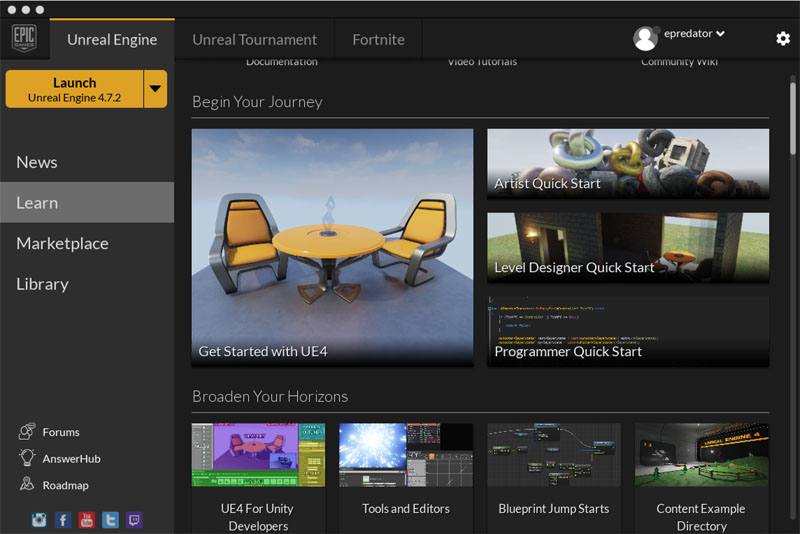
The one document that leapt out is UE4 for Unity developers. This is addresses the differences and similarities between the two environments. Some of it is obviously a bit of “this is why we are better” and in some cases not strictly correct, particularly on object composition. However it is there and it does help. It recognises how huge Unity3d is rather the that slightly more arrogant stance that the toolset seemed to have as “we know best”. That is just a personal opinion and a feeling. That may seem odd for a software dev tool but when you work with these things you have a sense of who they are for and what they want to do. Unity3d has demo from humble beginnings as an indie tool grown to a AAA one. Unreal Engine, obviously had to start somewhere but was an in house toolkit that grew and grew making AAA titles then burst out into the world as a product. They both influence one another, but here it is the influence of Unity3d on Unreal Engine I am focussing on.
Also on this launcher are the quickstarts. Showing the roles of Artists, Level designer and programmer as different entry points. Another good point, talking the right language at the start.
Unity has a lot of sample projects and assets, some great tutorials. Unreal Engine now has this set of starter projects in a new project wizard. It is easy for more experience developers to sniff at these, but as a learning tool, or a prototyper being able to pick from these styles of project is very handy.
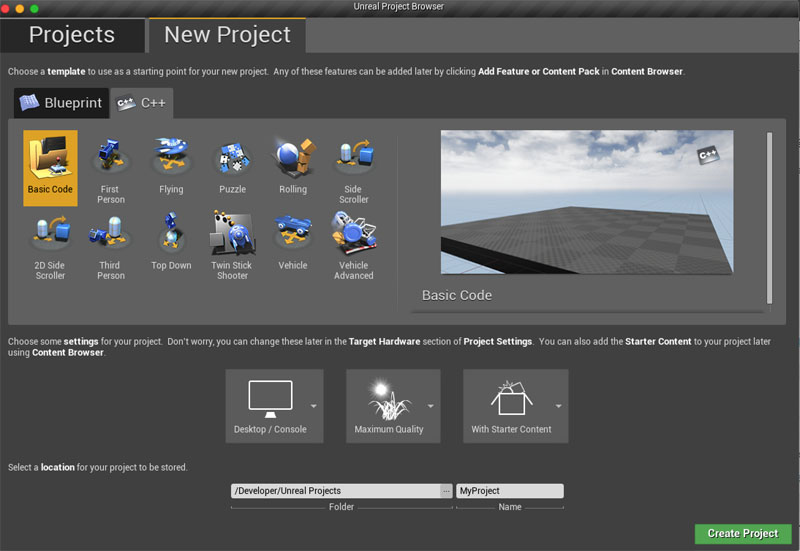
I had a number of “oh that’s how unreal works!” moments via these. First person, puzzle, 2d side scroller, twin stick shooter etc are all great. Unity3d does of course have 2D or 3D as a starting point for a project. Though I have always found 2D a bit strange in that environment, as I have build 2d in a 3d environment anyway.
The other interesting thing here is the idea of a C++ version or a Blueprint version. Blueprint is Unreal Engine providing a visual programming environment. Behavours and object composition is described through a programming facade. The blueprint can mix and match with C++ and shares some similarity with a Unity3d prefab, though it has more interactions described in visual composition than just exposing variable and functions/events in a prefab. Whilst blueprints may help people who don’t want to type c++. like many of the visual programming environments it is still really programming. You have to known what is changing, what is looping, what is branching etc. It is a nice feature and option and the fact it is not exclusively in that mode makes it usable.
Unreal Engine also seems to be happy to work on a Mac, despite much of the documentation mentioning Visual Studio and Windows it does play well with Xcode. It has to really to be able to target iOS platforms. So this was another plus in the experience.
The main development environment layout by default is similar to Unity3d too. All this helps anyone to have a look at both and see what works for them.
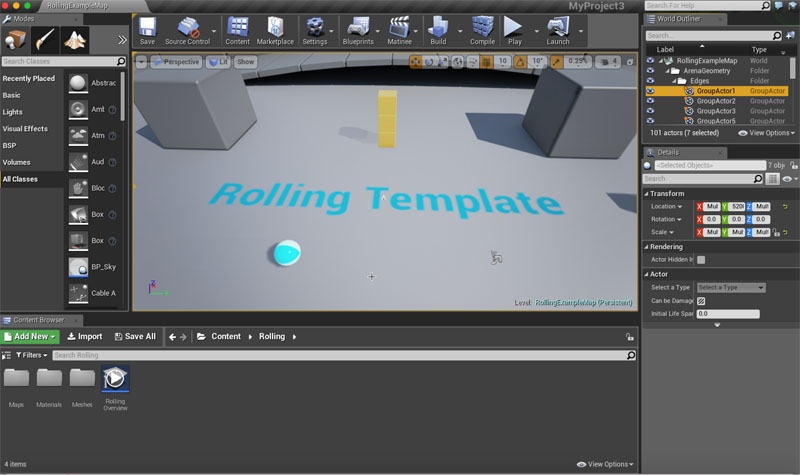
I am not a total convert yet. I still need to explore the multiplayer/server side of things. The ability to interface with other systems (which all my work ends up needing to do). Though I am not quite so turned off by it now. It seems a real contender in my field. So just like all these things you have to give it a go and see how it feels.
Number 5 is alive (Unity3d 5.0)
Yesterday at GDC Unity3d 5.0 got released. As a long term, long time user of it this is an interesting time. Many of the fancier features around how graphic designers can make things look nice are not that high on my list of things I needed, however its all very welcome.
As a pro licence holder I also now seem to get some extra discounts in the store and a few perks which is nice 🙂

I had tried the beta of 5.0, but I was mostly on 4.6 as this is the version that every project I have worked in and also introduced the shiny new user interface pieces of code.
Before wrecking any projects with imports and checking all the old stuff worked I thought I would just throw together some things with the new basic prefabs and assets.
There is a nice ready rigged car and also a couple of planes in the kit bag now.
So…
I created a terrain, imported some SpeedTree trees from the asset store. Asked it to mass place the trees for me. I added a wind zone to make the trees blow around.
I then dropped the car prefab not the scene, made it blue. (That gave me the car motion on keys, sounds, skids etc.)
The camera I moved to attach to the car.
Just for fun I dropped a few physics objects in it. Spheres and blocks.
So now there is a car world to raz around in knocking things over.
All this took about 15 minutes. It is here (if you have a unity plugin) Make sue you click to give the world focus then the arrows work to drive around.
OK it is not quite Forza Horizon but as a quick dive into Unity3d it was a good test 🙂
I then built an HTML5 version. This is slightly more clunky as it is early days for this rather than the player. It is also 200mb as opposed to the 30mb of the player version. So rather than sit and look at a blank screen the version is here on dropbox. That makes sense as of course the HTML5 version has to bring its own player type scripts.
Even with Unreal engine now out there for free Unity3d seems much more accessible as a techy.
I am looking forward to exploring some of the new stuff like the mixing desk for audioscapes. I also seem to have Playmaker free to download as part of “level 11” on the shop. That lets you create more flow chart based descriptions of camera pans etc.
The extra elements in the animation system also look intriguing.
As Unity3d covers the entire world of work when it comes to games it is hard to be great at everything, but it does let anyone, techie, designer, musician, animator etc all have a look at one another worlds.
I think the next project, in 5.0 will be the most interesting yet.
Martial Arts, Science and Tech for Secondary School
Having returned for a great snowboarding and skiing holiday with the family,
I dived straight back into presenting and explaining science and tech. This was a slightly different request through STEMnet though. A local secondary school teacher asked if I could come and take about biomechanics and martial arts to try and help her students see why science is still an important subject to stick with.
I ran two sessions but built a new presentation specifically for this audience and reason.
Usually I am explaining tech, the future, metaverses etc but putting things like Choi Kwang Do and learning guitar into the mix to make things a little more human.
This time though the hook was martial arts. As Martial arts are not generally taught in school (though the should ideally be part of the curriculum) they are something that has a degree of intrigue to people. Choi Kwang Do in particular is based around a lot of ground up application of scientific principles. It is also not a combat sport, but a defence art aimed at improving your overall mental and physical well being. i.e. it’s idea; for this sort of talk.
I am not going to post the presentation as it featured a lot of video, very few words on slides and a lot of talking and demonstration.
The format though was….
1. Intro to who I am, what I do. I was wearing my Dobok and belt as part of the impact, but indicating my background and work as a techie. I also showed some custard pie throwing from The Cool Stuff Collective. My aim was to show that breadth of knowledge and experience is important and the ability to change is key.
2. I gave a potted history of CKD and showed some of the variety of people performing CKD. I showed predlet 1.0 in a video at a showcase event. It had all ages, sizes and abilities of people in it. The aim to remove the macho, teenage boys only, type of image and engage the entire class. I explained the classes that Master Scrimshaw runs in basingstoke too. I also had the values and pledge on screen to mention.
3. Next up was to talk about Psychology. In part this was about mental states. Dealing with the transition from relaxed, to wary to fight or flight. How the fight or flight state causes massive physical and chemical changes. How being aware of those changes, finding ways to avoid or positively use those is a fundamental part of any martial art. How being in the red and stressed when you don’t need to be will make you ill etc.
4. Physics was next. I pointed out that in a martial art Force = Mass x Acceleration is key. Learning ways to project as much of your mass as possible, as fast as possible is what the techniques are designed to do. Understanding forces and what they are apply to any sport, golf, football, tennis. However I also broke out into showing how we need to understand forces like gravity and cohesion in game development and animations. Here I was aiming to jump subjects to show that the same science and understanding is needing in something very physical and in something, like games development, that is more sat at a desk. The same science.
Also here I played a little trick. Whilst talking about the forces I suddenly jumped into stance and gave a very loud guttural kihap (Martial art shout). This made pretty much everyone jump. A fairly drastic pace change but the aim was to then remind everyone of the conversation about fight of flight earlier on. I pointed out that for me as the shouter, I had gained control, I had positive vibes and chemicals flowing and I was ready. For the class they were for a fraction of a second confused. Their body will have gone straight to code red, in fact jumping was part of fight or flight but almost taking them into tonic immobility, frozen in fear. A simple loud noise, out of context had caused metabolic changes in all of them. i.e. make the science personal and relevant.
Those that already did martial arts, there were a few in each class, were less bothered, seemed more relaxed as they were subconsciously dealing with the threat assessment.
5. I continued to talk about physics and relate that to biomechanics and anatomy. Understanding how to flow movements across your body to generate the acceleration.
6. This led to the neuroscience part. I shared how we learn patterns and sequential movement fits with the way the brain likes to absorb information. Moving from short to long term memory and able to operate when in flow mode works better if the thing you are learning has a completeness to it and a known pattern. In CKD we start and finish in the same place in most moves, we also follow a rounded non stressful sequence. Again I related this to video games and how we learn patterns to deal with situations in games. Discovering the pattern is the joy of play, followed by the mastery of that pattern, getting faster and better scores. Good games need to layer new patterns on old to avoid boredom. Likewise in CKD training we layer onto of mastered moves and patterns with new ones. At its root it all goes back to basics.
I also discussed contralateral movement, working the whole body on both sides for both parts of the brain to create cross hemisphere pathways as the brains neuroplasticity is exercised.
I used the example from Heston Blumenthal of the cinnamon and vanilla ice cream too. Again this was to break the subject, change the mental senses used by the group. With the ice cream made from both vanilla and cinnamon if you sniff cinnamon before tasting the ice cream you will only taste vanilla, like wise with vanilla sniffed first you will only taste cinnamon. This illustrates how you brain and neurochemistry is rigged to look for large changes. You brain filters things out to avoid overloading. The familiar is relegated in favour of the new.
I also discussed how the brain goes into an intense learning mode after a burst of exercise. This seems to be related to reflecting on what a situation was that caused you you be stressed and to escape, how you did it and how you won’t get eaten/killed/caught next time. So we can use our naturally evolved mechanism to increase out learning ability by piggy backing on that fight or flight calm down state.
7.Last up was metabolism. A basic example of the Krebbs cycle, the production and use of ATP as a mini fast access energy source in cells. I did not major on this but used it as a framework to discuss the 15 second bursts of exercise versus the 30 minute aerobic ones. In a defence situation you need to be explosive and able to release the ATP energy, quickly and efficiently and then get away. (Or not be there in the first place which is much better!)
Before heading into the last section I also shared the amazing journey of Sabunim Robbie Close. He went from a very quiet and shy teenage to an assistant instructor then a blackbelt and was then picked to go to Hanseo University in Korea to study a Degree in Choi Kwang Do. This martial art had transformed his outlook, and his life. We had the pleasure of him popping along to Basingstoke for a visit. As the class I was talking to was the age he was when he started it was great to have such a positive role model to share.
8.My final section moved more into the normal territory of discussion using the kinect to see how the body works. I related this again to biomechanics and then also to how we animate game characters and rig bones and joints. I ended up showing Microsoft HoloLens as a mandatory virtual world/metaverse, look here is the future and you can be part of it… the of conversation.
It was a very productive session I think on both occasions, and I hope to run some more. It covers all sorts of science and tech and it may help a few people see the relevance of science in life, or even better see the relevance of a martial art such as Choi Kwang Do.
Learning to teach – CKD and suppressing ego.
This weekend both @elemming and I, along with 140+ fellow Choi Kwang Do practitioners in the UK met for the annual instructors course led by Master Nigel Brophy (6th Dan Black Belt). @elemming has been promoted, along with her fellow cohort of willing students to an assistant instructor at Basingstoke CKD and so now wears a blue dobok. I along with 2 other fellow blackbelts were promoted to Chief Instructors and now wear black and gold.
We are all volunteers, but are willing to forego some of our personal training in order to help and explain Choi Kwang Do to others in the class. I think we all generally find that teaching, having to explain how something works, responding to questions and helping others is as rewarding as just getting on with your own techniques. IT is what makes CKD such a friendly and interesting environment to learn in.
Different people have different approaches to teaching, but everything we do is done in a positive way. This is about a journey, and meandering turns and detours are all part of it. We do have discipline, but it is more of a positive re-enforcement of the good. Who ever is out front guiding, teaching, calling etc is in charge.
One of the hardest things to work on, is not the punching and kicking, but the removal of ego. Watching and listening to Master Brophy I noticed it is possible to be a highly passionate speaker and presenter, an expert in an art form and yet not do it for the applause or the instant buzz of being the ‘star’. To motivate and educate a large body of people they have to believe in you. To do this you have to show your credentials, give them something to say, aha! they know what they are doing. If you truly have the skills, time served, awards etc that is really the easy bit. However it is so easy to tip over the top and let your brain, and mostly your ego, slip into a comfort mode of adoration, or celebrity.
When I do presentations, or evangelise about things, such as the metaverse or STEM in schools I have to switch to a more amplified version of me. If you are put in front of a camera on a TV show, standing on stage with a conference hall full of people, in a classroom full of pupils, you have to enthuse, you have to say look at this and look at me, otherwise it won’t be very interesting. I remember when I used to not want to stand up in front of people and talk. Thinking, well everyone must know what I know, I will just be boring them with the obvious. I also know the feeling of election that people do want to hear what you have to say. When what you are saying is getting a lot of traction and you are very much in demand. It is there you have to check yourself. Unless the thing you sell, enthuse etc is just your own fame and celebrity, in which case just carry on 🙂
So I came to CKD at a time when I had felt a lot of demand for me presenting, but the classes gave me a chance to empty the mental cup and just learn, just be part of a group with no specific responsibilty. It gave me time to practice the off switch.
The problem is, when I get something, when I believe in something and enjoy something so much I have to share it with others. I have forever been told I should be a teacher, but I prefer to not lecture but bring people along with me, help them discover their own path. Luckily, that is precisely what working as an instructor in CKD has enabled me to do. In class I get to both be part of the class, to switch off and focus, I get to teach individually or small groups and I also get to stand up front and do the whole thing. I feel the balance of expectations to please others, or duty to get it right and that little good part of the ego that gets fed by helping others and seeing them progress.
Master Brophy put it well, he mentioned the more you know the more you realise how much you don’t. That is the experts dilemma. He also tempered that with pointing out than when you stand in front of a new student in your blue suit or black suit to teach them something they have never done before, they may well look at you and think you are Bruce Lee.
I think the trick here is to use the fact your are Bruce Lee to them, without deluding yourself you are in fact Bruce Lee.
As with all aspects of CKD other than the physicality of the martial art it is a constant learning experience and evaluation of how we work as humans. The technology, in this case, is our bodies and minds. We explore what we can do with them, for ourselves and others. We deal with scary situations all the time. It may be not being able to remember a pattern, counting out load in Korean in front of others, wondering how to reach a distracted fellow student or holding a shield for a powerful kick. All these prepare the brain to deal with adversity. Teaching and instructing gives the scary part of ego to deal with.
So it seems to me the sooner we get people to experience this sort of thing, in schools and offices, the better. We have a cult of celebrity. This feeds directly to the ego, to the wow I want to be famous feeling. Either wanting to be a premiership footballer or a big brother winner seems to be many a kids ambition. The trappings of fame at a major level can be experienced and felt in a much simpler way, in a safe environment. Stand out in front of class and have everyone follow your every word, then stand back in the class with everyone, whilst the next person takes the stage. That I think teaches a little humility. Having felt that, the next time up front starts, just a little, to become more about the audience.
Whether you believe me or not, that is how I feel about all my evangelising, the TV show was that. I wanted to everyone to know how cool all this tech was, to feel it, to take it and do something with it. I had dabbled with the “fame” thing as one of the corporate poster children for virtual worlds. I had seen the jealousy that created in others. I felt the pressure of the spotlight. I also felt the waning of the “fame”. I dabbled with various ways of exploring my outward persona, trying very publicly to keep aligned with my private persona too, whilst also dealing with these conflicting pressures. It was a a feedback loop though, the more I had done the more I had to do to keep it going. That is not a bad thing though.
I see in Master Brophy a fellow evangelist, though one with much more experience!. Evangelists believe in something, know that its the right thing and the right way forward and want to help, really help, people to see that for themselves. What I hope to do is take my still fledgling knowledge of this martial art and make it as much a part of my willingness to share and enthuse as any of the other cool technologies. The tech I talk about has always been about how people can benefit from it, get some fun or productivity from it. Obviously I have written and blended a few time with the two like here and here. CKD is a scientific based martial art, from the neuroplasticity or the brain, to the biomechanics of the human form to the psychology of teaching and inspiring.
In all that, trying to keep that ego in check too 🙂 (though here is a picture look at me!)
